In recent years, companies’ contributions to society have increasingly been under scrutiny. This has accelerated social contribution initiatives, including efforts to achieve the SDGs. As people's interest in social contribution has grown, an environment that enables individuals to easily provide financial support through platforms and other means has been established.
On the other hand, there are “black boxes” where it is not clear where and how donations are used, and it is difficult to visualize and evaluate social contribution activities that are not measurable in terms of money.
Against this backdrop, Dentsu Innovation Initiative (an R&D organization of Dentsu Group, hereinafter “DII”) and Panasonic Holdings Corporation established the Traceability Infrastructure Development Project to promote social contribution activities to address environmental and human rights issues using Web3 technologies.
How can Web3 technologies facilitate social contribution activities? What is the potential of Web3 in this area? We interviewed Mr. Yuki Minoda of Panasonic Holdings and Mr. Junichi Suzuki of DII.
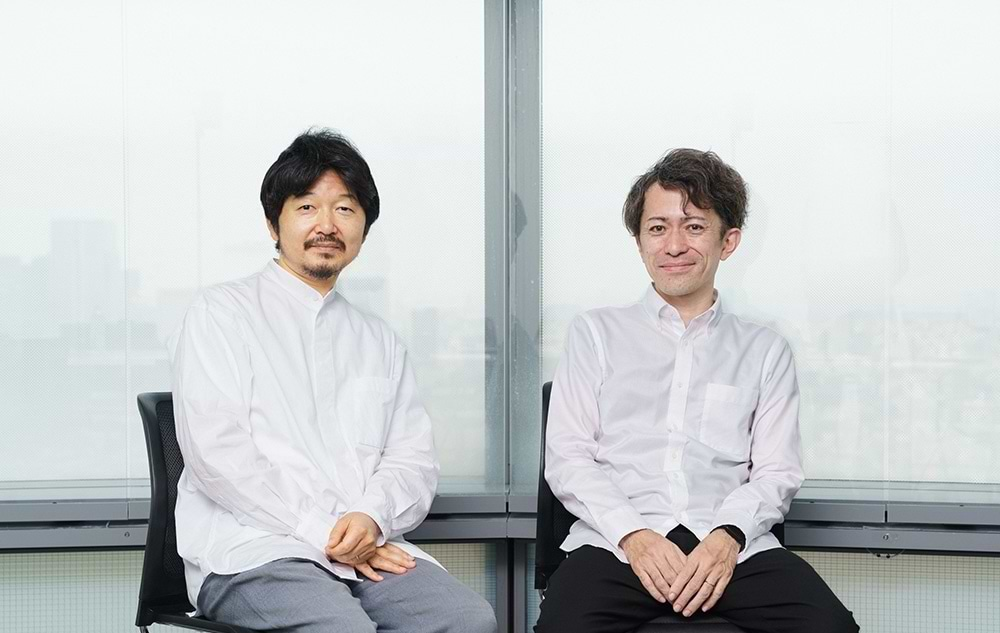
Using blockchain technology to visualize the traceability of donations and “non-positional goods”
—What is at the core of your traceability for promoting social contribution activities? Could you share an outline of the project?
Suzuki: To give a summary, Japanese university students choose social issues that interest them and create a portfolio of donations while Japanese investors, mainly seniors, support these students financially to help address the difficulties the recipients face. The students, seniors and other people who have been involved i receive awards, including non-monetary ones, as a token of gratitude and support from third parties. Basically, this is what the project is about.
Let me explain the mechanism in more detail. The project is built on blockchain technology. By ensuring rigorous traceability, we ensured users can keep up to date on detailed information about what the donations are used for and their results. The non-positional goods (goods that cannot be bought using money) of the social contribution activities are converted into tokens which can be used to make credit decisions when people are searching for jobs and engaged in other activities. This also enables investors to communicate with the people being supported and the younger generation through the traceability foundation’s channel. Consequently, they can obtain opportunities to interact and connect emotionally, something that cannot be obtained through conventional forms of financial support.
—I see. So the project benefits students, the people being supported and investors. Allow me to ask you about the specific mechanism later on. Could you share with us how and why you started the project in the first place?
Suzuki: The concept started when we attended a conference in 2023 that was held at the United Nations Headquarters as part of Climate Week, one of the world’s largest climate change events. We discussed what was the most critical human rights issue in the world. The most common answer was the educational disparities between the sexes in the India region.
In India, women are a very small part of those attaining a higher education. Against this backdrop, there are problems such as women lacking the freedom to choose their occupation and incidences of human trafficking. Donations are being made from around the world to solve these problems. Reportedly, however, most of these donations are spent on local groups’ personnel expenses. Large commissions are deducted through multiple layers of intermediary exploitation. In addition, there have been cases where parents have spent the money on living expenses.
Most donations do not go to their intended recipients. Actually, this problem is not limited to India. But in India, there are women who are not documented in their family register. Aside from their financial difficulties, they do not have means of identifying themselves. The combination of these problems greatly restricts women’s development of their careers in the country.
—That is a serious problem.
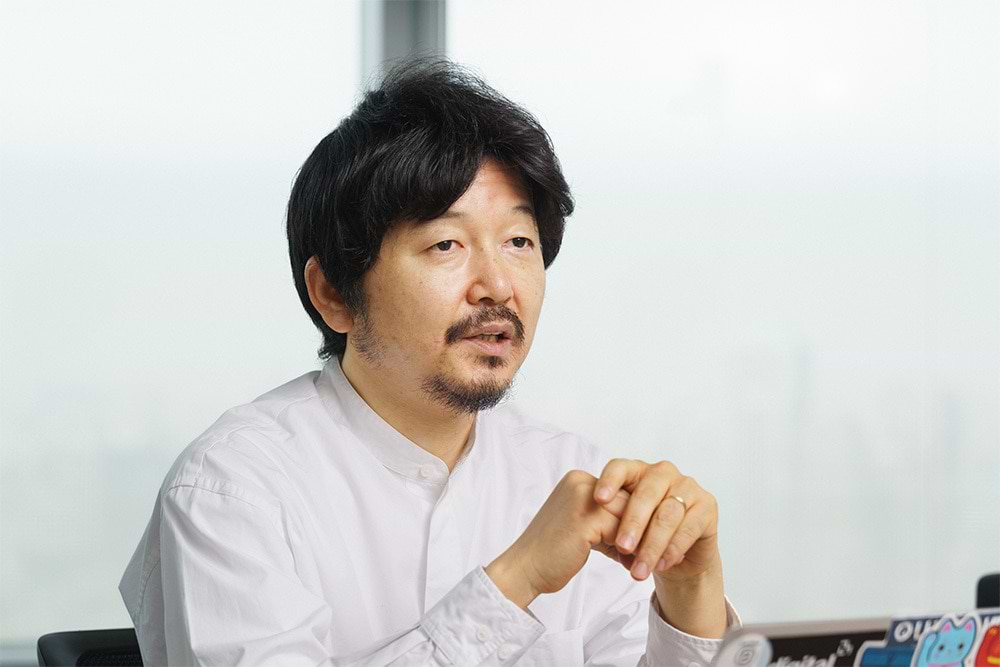
Suzuki: When I heard about this, I came up with a possible solution by using a self-sovereign identity information environment which is characterized by the technologies I have specialized in, especially the blockchain technology known as Web3. So I began to draw up a plan. In the process, I sought advice from Panasonic Holdings’s Mr. Minoda, as we had known each other for a long time. The donation problem was not limited to India, and I saw a need for a community oriented toward sustainable social contribution activities to address environmental issues, human rights issues, and educational disparities.
—Mr. Minoda. What did you think of Mr. Suzuki's idea?
Minoda: It was aligned exactly with what I wanted to do. In 2022, the Panasonic Group formulated Panasonic GREEN IMPACT (PGI), a long-term environmental vision, in pursuit of a society in which it is possible for people to live better lives and coexist with a sustainable global environment. More specifically, our target is to reduce CO2 emissions by 300 million tons or more by 2050.
But it is very hard for a single company to achieve this target alone. Co-creation with society and customers is very important. A sustainable community for contributing to society sounded like it could possibly play an important role in promoting this sort of collaboration and help improve people's awareness.
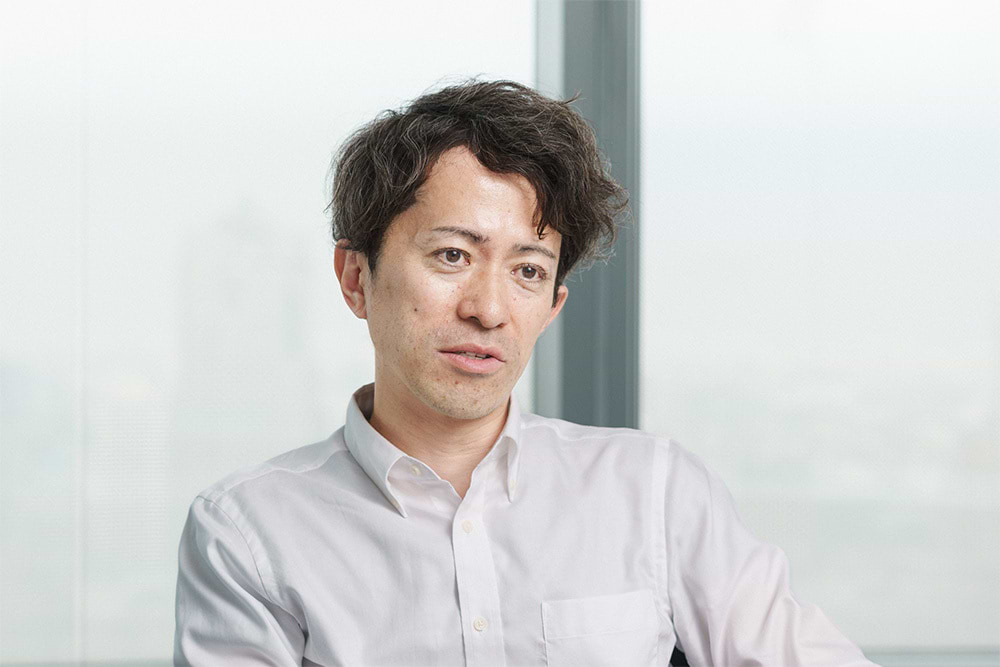
Suzuki: Earlier, I mentioned non-positional goods. I learned this phrase in conversation with Mr. Minoda.
Minoda: Oh yes, that's right. Our company has had the goal of pursuing better lives for the future for a long time. In the process, we have been discussing the need to carefully think about the importance of mutual care, respect for others, compassion, and other values that cannot be measured currently through economical measures, in addition to happiness of having good health and a good environment.
Incidentally, the technical division of Panasonic Holdings formulated the Technology Future Vision in July 2024 to show what the company wishes to achieve by 2040, a "Co-caring society built on thoughtful choices: A society where individual choice naturally leads to caring for each other and the planet," and the direction of research and development toward the achievement of this wish. The Vision says, "A harmonious state of mind and body encourages co-caring relationships with those around us," referencing being oneself and fostering generous human relationships.
Konosuke Matsushita, the founder of Panasonic, said, “a company is a public entity of society.” As this quote says, we believe that the mission of a company is to contribute to society and that profit is given to us by society as a reward for our contributing to society. The managerial policy is aligned in part with the idea of non-positional goods.
Suzuki: A typical example of non-positional goods is good conduct and social contribution activities. Panasonic uses the phrase “intoku wo tsumu (accumulate good deeds when no one is looking)” to describe this. I found it interesting. Values or evaluation criteria like this have remained low-profile to date.
If this can be visualized by the world using Web3 and a new asset evaluation index that third parties can use, it may be possible to build a mechanism for providing incentives to people who engage in social contribution activities or have values you can identify with, instead of limiting special services to wealthy people or people with an expensive watch on their wrist, as we have conventionally done. In this latest project, we foresee the establishment of an economic zone for these non-positional goods.
To date, DII has engaged in activities such as J-WAVE’s LISTEN+ and Yoichi Ochiai Summer School to build an information environment where NFTs are used to record individuals’ regular activities. For example, since 2019 we have issued certificates of graduation as NFTs to students who graduate from Yoichi Ochiai Summer School. Based on this information, a local municipal government in France offered to exhibit thumbnails of the visual works of the 20 students enrolled in the school this year by printing them on the front panels of roadside transformers in France.
If this happens, the students would be paid as artists. They will have benefited from the Web3 information environment independent of a specific platform. By having this experience, some of the students may realize their creative potential. This is exactly where I can see the significance of allowing the records of individuals’ everyday activities to be treated as a portfolio, in other words a collection of NFTs that are a result of the emergence of non-positional goods, a new mechanism for evaluating assets.
Interactions between Students, People Being Supported and Seniors Make Donations Worthwhile and Lead to Sustained Support
—Could you explain how the project works?
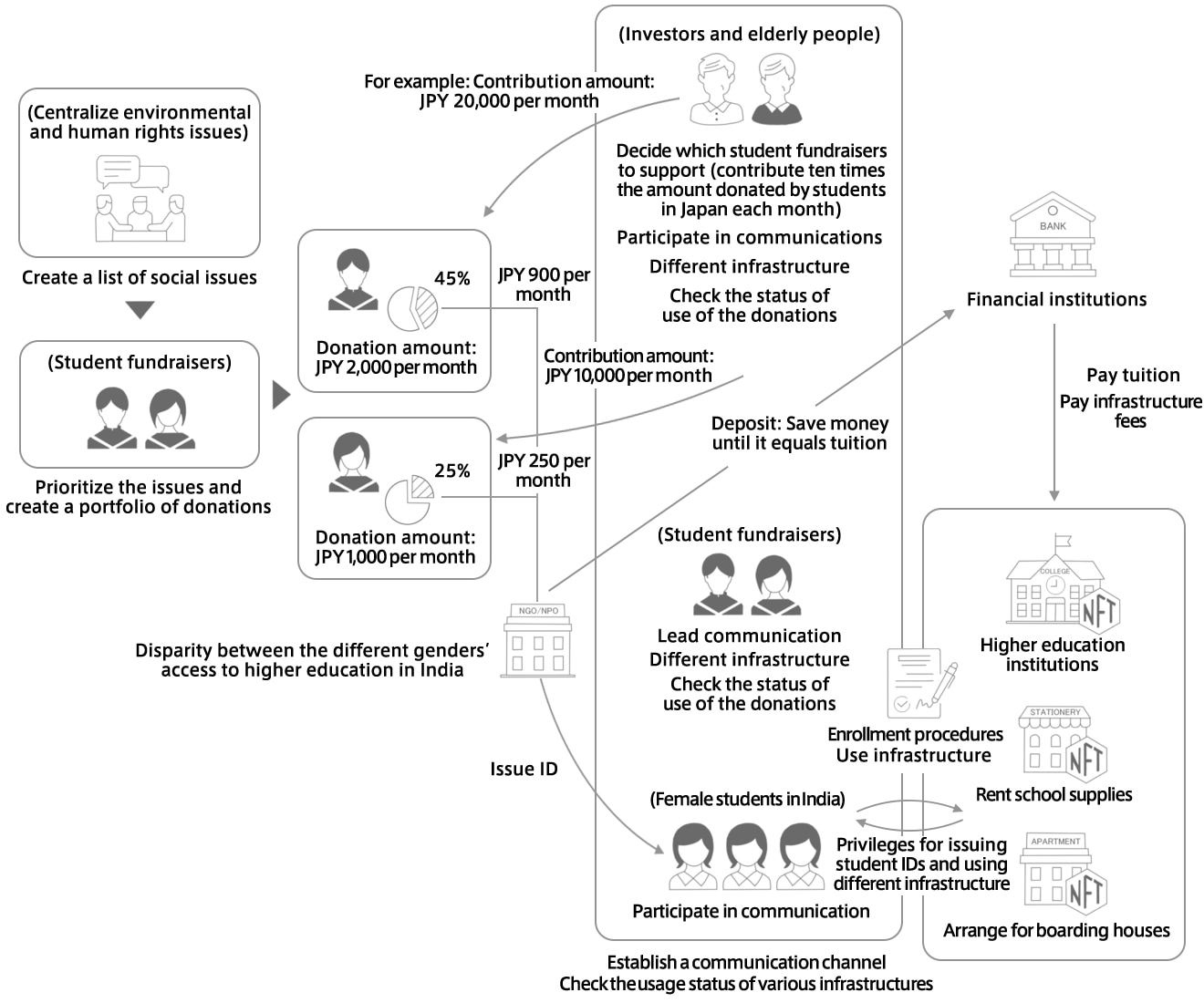
Suzuki: This diagram shows an overview of the project. First, we create a list of social issues where the project can be expected to create value. To do this, we cooperate with Fundrex, a company specializing in consulting in the social sector.
Then, each student prioritizes the issues on the list and creates a portfolio to decide how the donations should be allocated. For example, a student who can afford to donate 2000 yen per month may appropriate 45% of it, 900 yen, to educational disparities in India and the remaining 1100 yen to decarbonization. A student may create a donation portfolio in accordance with his/her interest. Furthermore, investors and seniors provide financial support by donating ten times the amount donated by students.
—Why do investors and seniors need to support students’ donations?
Suzuki: If possible, it is desirable to continue to donate tens of thousands of yen, not thousands of yen, to impact problems in a way that is significant enough to solve them by, for example, enabling Indian women to go on to higher education. Conventional donation activities mainly involve financial support provided via an organization. This makes it hard to communicate with the people being supported and has posed a barrier to the continuation of donations.
In this project, we think that it may be possible to continue support by enabling seniors with grown-up children or grandchildren to keep in contact with students and support donations and thereby foster affection and fulfillment by providing support to someone they can think of as a non-biological grandchild. Using a traceability foundation enables students, people receiving support and investors to interact with one another through this channel. Providing opportunities to join this cross-generational community is an effective non-monetary reward.
—Could you explain the way by which the people being supported use donations?
Suzuki: Donations are appropriated for uses such as entrance examination fees and tuition for higher education institutions, buying school supplies and arrangements for boarding. The donations are deposited to a financial institution until they reach a sufficient level. The money may be paid from the financial institution to a local organization using a process for checking the validity of the payment using token-based authentication technologies depending on the occasion, such as when a person being supported takes an entrance examination or passes the entrance exam and is conducting school admission procedures. Using NFTs with a specified use to lock and unlock deposits prevents the money being used for purposes that are not in line with the donators’ intentions.
Rigorously managing the use of donations can prevent undesirable events such as money being misappropriated by a parent of a female student and beneficiary rights being resold. Furthermore, smart contracts (automating credit-guaranteed processing without a third party’s intervention) using blockchain technology can reduce intermediary costs to a minimum level.
Since there are cases where women are not documented in family registers, we are also considering allowing them to take entrance examinations and conduct school admission procedures without official documents for family registration. This may involve having the United Nations or another internationally credited organization issue them an ID.
This flow of actions is intended to address educational disparities in India. Going forward, we will also devise schemes to promote decarbonization initiatives to address environmental issues. For example, we may give incentives to users who choose dryers that use blockchain technology to visualize data about them and are made in a way that reduces carbon emissions throughout the supply chain, including production, logistics and other operations. It may be possible to build a mechanism like this.
Minoda: In terms of the environment, this mechanism may be widely expandable to the circular economy, the revitalization of local communities, nature positivity and other related issues in addition to decarbonization.
Suzuki: You may associate incentives with gift cards or other things that are convertible into cash. But they are more than that. For example, if you are normally eco-conscious, you may feel incentivized when you know you will not be asked whether you need a plastic straw every time you buy a drink at a cafe.
By visualizing many different kinds of value as an NFT portfolio and making them analyzable, we will strategically shift from the customer loyalty strategy, which has been designed based on conventional monetary evaluation indexes, to the kinds of value that each individual customer values. Of course, the conventional monetary kind of positional goods is one way to consider value. However, as one example, companies or business operators that values consumers who have been committed to environmental issues, have not accumulated knowledge about what kind of loyalty they should offer, or what types of reward and the channels are appropriate for providing rewards to the consumers.
Minoda: We can identify many incentives in our everyday lives, such as non-positional goods. Value and life experiences that can be bought by money and those that cannot are seamlessly connected to each other. You tend to look at things that money can buy, but you are surrounded by many valuable things that money cannot buy. Visualizing them using the power of technologies and connecting them in cooperation with likeminded people should lead to the creation of an economic zone of non-positional goods.
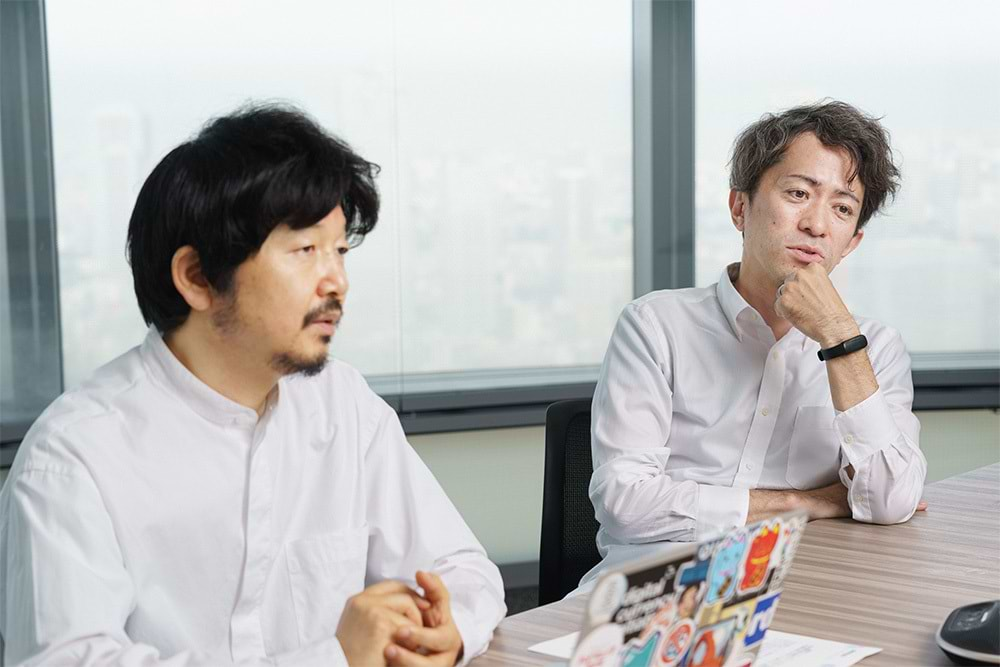
Shifting to a society that embraces not just material, but also many different kinds of wealth
—In addition to dentsu and Panasonic Holdings, the companies that DII is conducting research with are also involved in this project. What are your thoughts about and your goals regarding your having many different companies participate in this project?
Minoda: Addressing social issues in cooperation with others can be more impactful than a single company going at it alone. As you might expect, it is easy to get support from people if it is based on the idea of working with others, rather than working on the issue on their own, to address a major social issue such as decarbonization. This is why we need to actively identify more likeminded people to cooperate in this project.
Suzuki: Do not hesitate to cooperate with companies that may be competitors in an existing business. Get in the same boat with these companies and seek solutions to social issues together, instead of sticking to your territory. Panasonic has this mindset and I really think the company is trustworthy because of this.
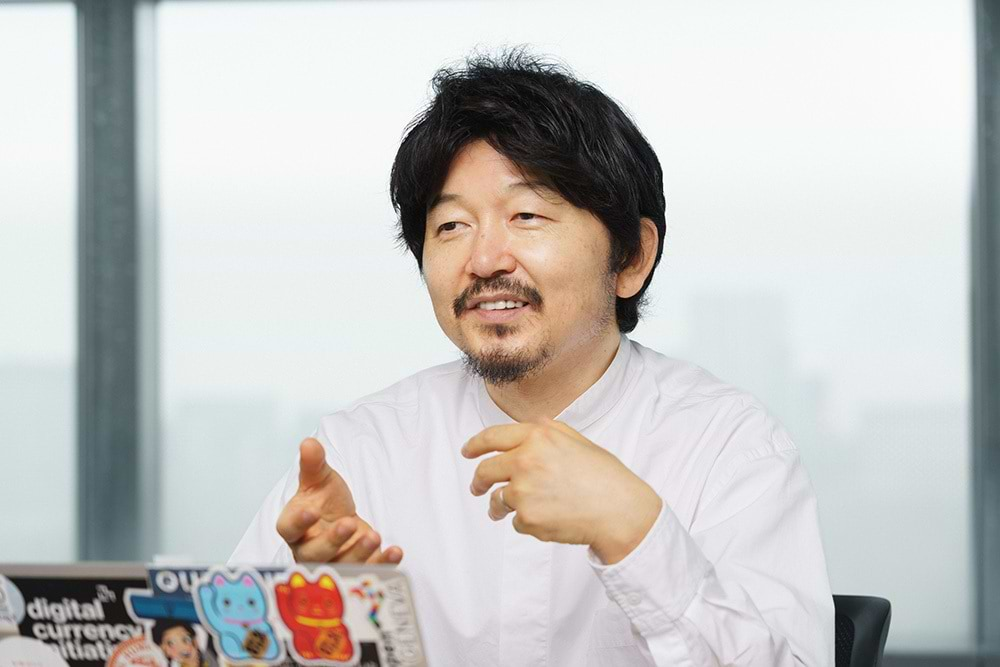
—Lastly, please share why you are enthusiastic about the social innovation you will pursue through the traceability infrastructure that you have recently established and give us your final thoughts about it.
Suzuki: Dentsu has a B2B2S (Business to Business to Society) management policy. This goal of this policy is the creation of value which leads to solutions to social issues and contributes to society through the resolution of the challenges that our customers face. This recent commitment will be an embodiment of B2B2S.
In conventional donation activities, many donors do not feel they made a good contribution or achieved something big because of the small amount of money they donated individually when compared with the enormous amount of donations in total. Consequently, many of these people have been discouraged from continuing their donation activities. The tendency is particularly striking among young people, including students. Even if you involve the people around you in a big movement and lead a fundraising project, you are evaluated by the amount of money you collected in the end.
This new project establishes an environment where you can, by visualizing your passion through the traceability foundation instead of the amount of money donated, receive support from people who are aligned with it. Thereby, you can seek self-fulfillment through the leveraged value of your contribution through the system. In this way, we can disseminate new evaluation criteria, specifically non-positional goods criteria, in an effort to create a society where the kinds of wealth that each individual possesses can be acknowledged as much as their material wealth, and people with different values can coexist.
Minoda: I believe we are doing what is good for society and for people. Many people have endeavored to do this since times immemorial. As the Japanese word “intoku” implies, you may be doing many of these things when no one is looking. Visualizing and recording these deeds and ensuring that they are rewarded for in some form is very important for making lives better. Establishing a mechanism for making this happen should enrich people’s lives. If you are in alignment with our activities, you are welcome to join us and energize the foundation together with us.
Suzuki: Indeed. First and foremost, we are looking for likeminded people who are willing to provide incentives for non-positional goods in many different forms. Panasonic has achieved a shift to low-carbon manufacturing processes, while other operating companies have leveraged their knowledge regarding loyalty programs to develop incentives in the domain of non-positional goods.
Going forward, companies will be rated by how they address society and will be expected to quantitatively visualize the results of their social contribution activities as well as their sales and profit. The new traceability foundation may be a place where these social contribution activities can be achieved. Please, consider joining us even if it is on a trial basis. We are waiting to hear from you.
Contact Information
- Junichi Suzuki
- Dentsu Innovation Initiative, Dentsu Group Inc.
- URL: https://innovation.dentsu.com/
- Email: innovation-initiative@dentsu.co.jp
